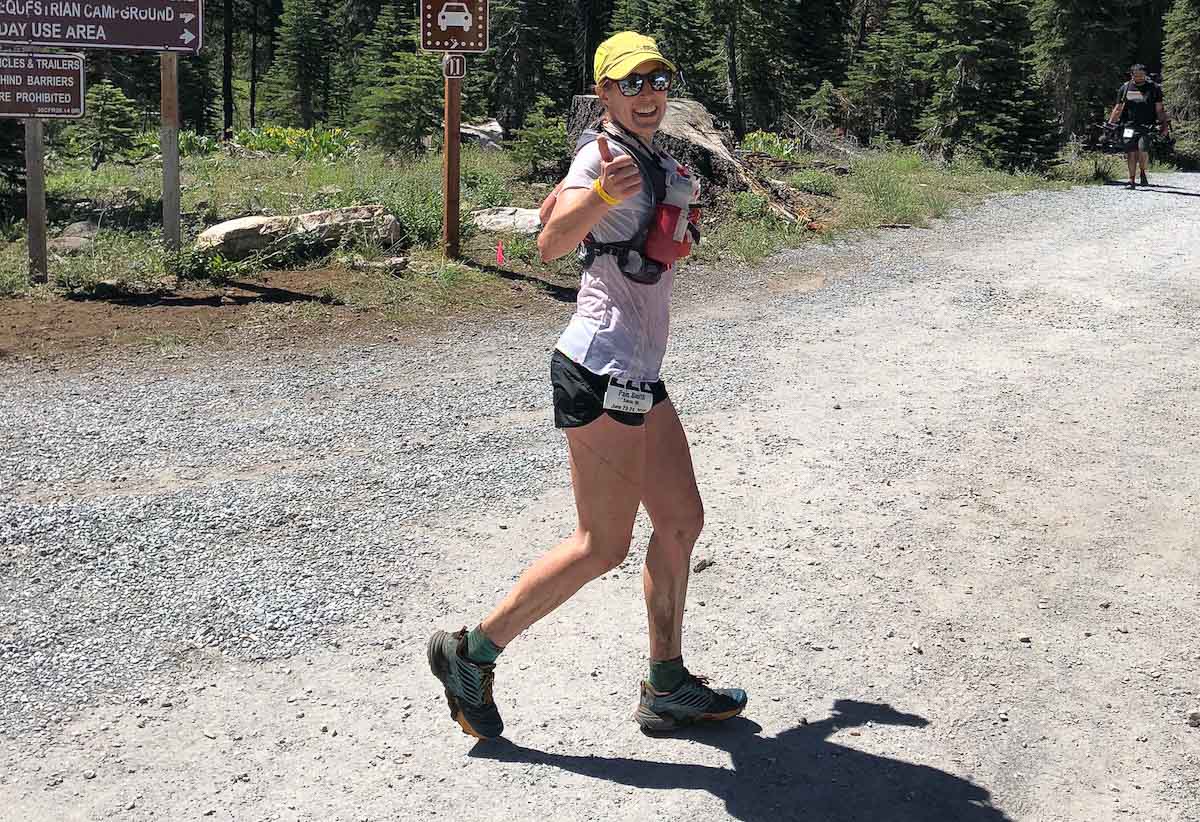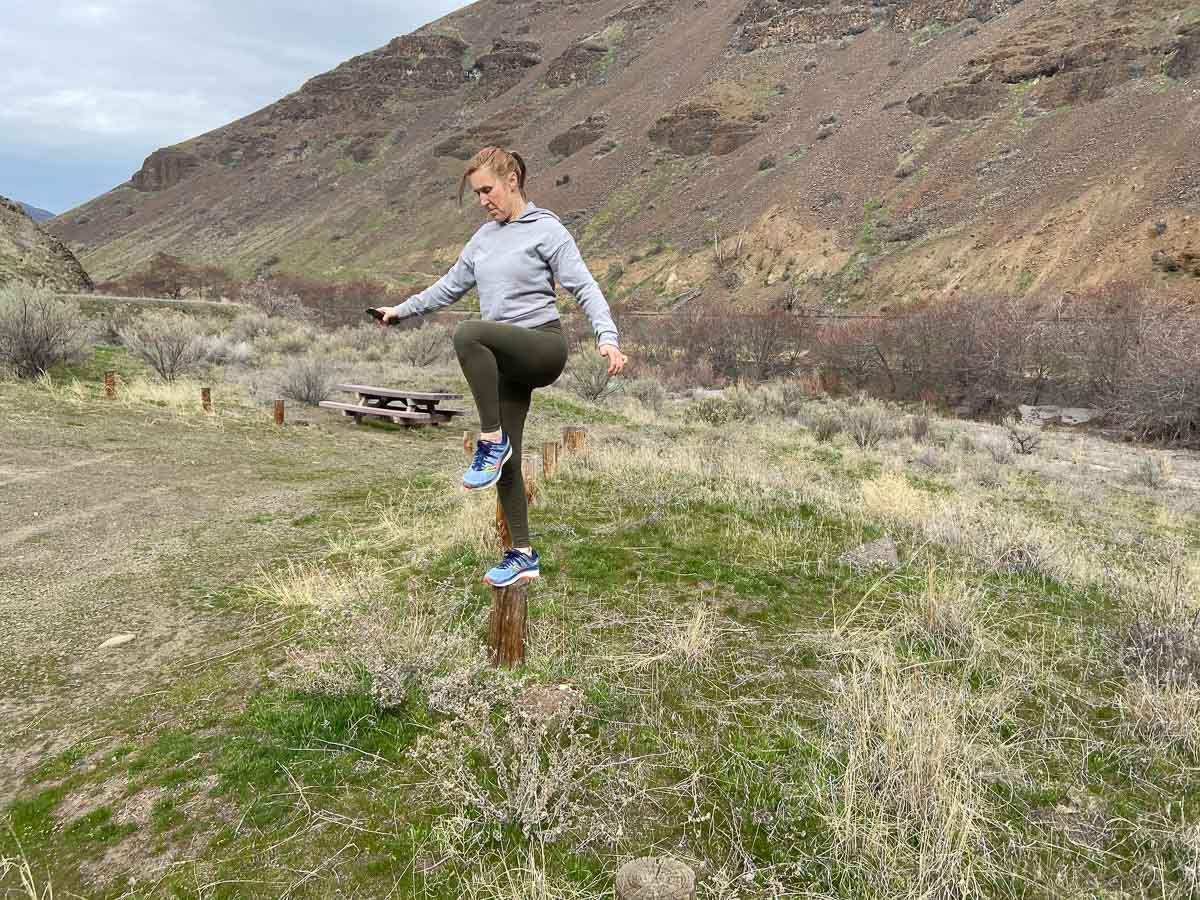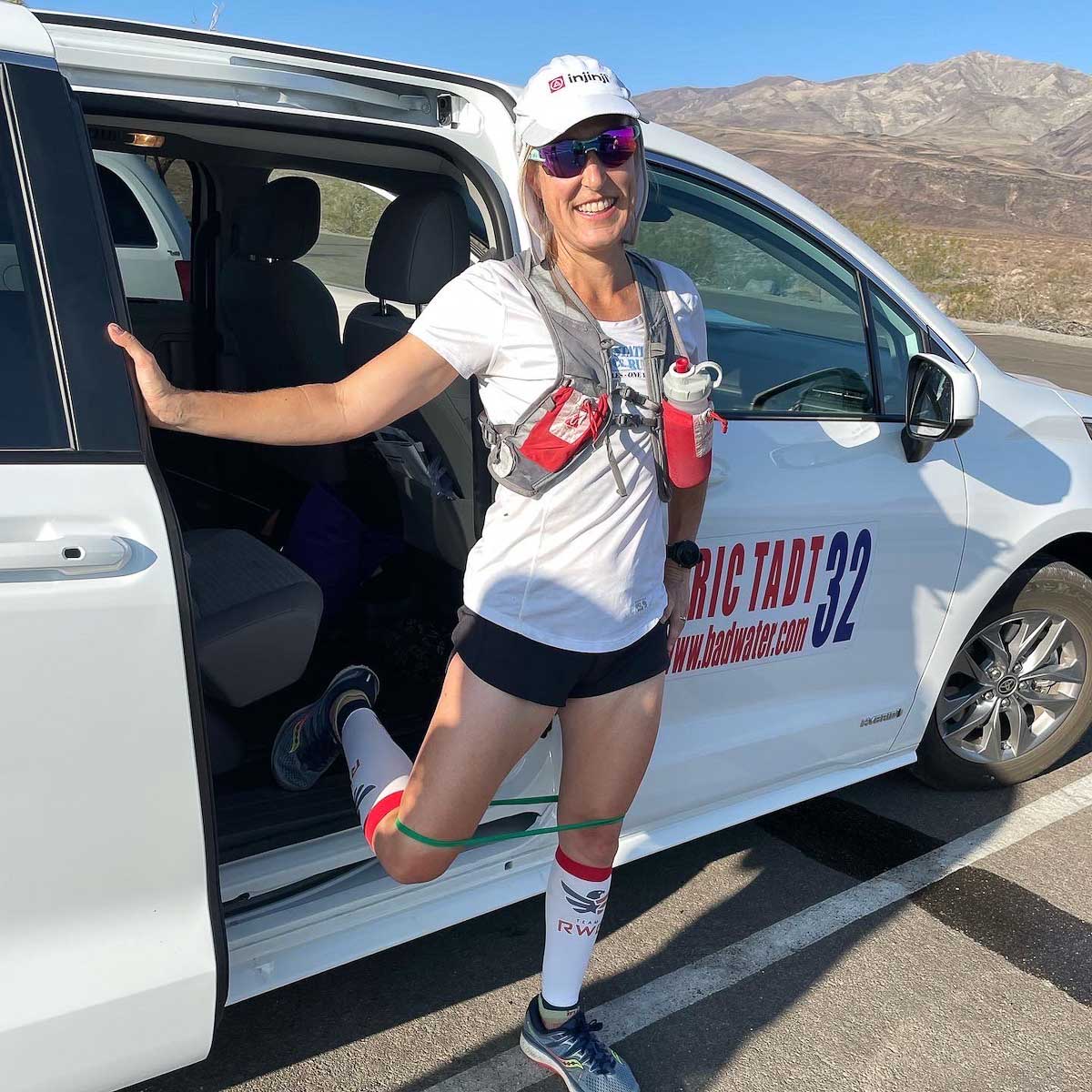If you run long enough, you’ll likely sample something from a full menu of serious running injuries: plantar fasciitis, iliotibial band syndrome, runner’s knee, hamstring strains, stress fractures, and more.
These bigger injuries test our tolerance for adversity and uncertainty. If you knew when you’d be able to run pain-free again, then injuries would be fairly tolerable, I can’t run for 36 days, but I’ll be good to go after that? Great, I’ll rearrange my race schedule and paint my bathroom.
Instead, we’re often buoyed along by other stories of recovery and return to form, which are almost as ubiquitous as running injuries themselves. As we age, however, there are fewer stories of people our age bouncing back from injury.
We’re also more likely to hear from our non-running peers that our injury means it’s time to stop running. It’s certainly easier to consider throwing in the towel. Many people I’ve interviewed for this Age-Old Runners series think injury is one of the primary reasons runners over the age of 45 stop racing and training.
I was thinking about how stereotypes of aging affect injury recovery during a conversation with a friend who is dealing with debilitating knee pain. She told me that what kept her going — what motivates to do her endless rehabilitation — was a conversation she’d had with Pam Smith.
Pam, who recently set a slew of women’s 45-to-49 age group records while running 100 miles at the 2021 Desert Solstice Track Invitational, had told my friend a hamstring injury had made it impossible for her to run a single mile at the beginning of 2021.
In fact, she’d had to stop running for four months before she figured out what was necessary for her to heal. I talked to Pam about her journey back from injury, and whether there was a way to help older athletes persevere with rehab when they’re injured.
Pam is 47 years old and she’s won tons of ultras, including the 2013 Western States 100 — you can watch her iRunFar interview and read her race report. She’s also represented the United States multiple times on the U.S. 24-hour and 100k teams, and placed second at the 2018 Badwater 135 Mile. She’s written about her ultrarunning training, racing, and adventures in her blog since 2008.
[Editor’s Note: This interview has been edited for brevity and clarity.]

Pam running the 2018 Western States 100. Photo: Libby Jones
iRunFar: Your story of recovery from injury is helping a runner I coach to remain hopeful. It’s motivating her to do her physical therapy and plan for the future.
Pam Smith: I appreciate that.
iRunFar: What happened that prevented you from running for four months?
Smith: I started having problems with my hamstring back in 2018. I was diagnosed with a partial avulsion of the insertion site. I was going to have some sort of tenotomy [a surgical division of the tendon] and a platelet-rich plasma injection. I was told I would have to be off of it for four months. But I had the 2019 Western States 100 and Badwater on my schedule, so, instead, I just didn’t train many hills for Western States.
It wasn’t as good as I wanted it to be, but I was okay, and my hamstring didn’t hurt me all that much. Then I ran Badwater, and during the first 10 miles, I thought, This hamstring is going to be bad. But I guess it warmed up or something, and I didn’t feel it for the next 125 miles.
After running 135 miles on [that hamstring], I thought it would be really stupid to go through a procedure that would take me out of running for four months with no guarantee that it would fix it. I thought, I’ll just keep running until my hamstring falls off.
I made it through 24 hours at the IAU 24-Hour World Championships in October of 2019. It was still just a little off after that. I did some physical therapy, but I was managing until December of 2020. [Author’s Note: Pam placed fourth at the 2019 IAU 24-Hour World Championships, running just over 152 miles.]
Then, while I was running on a really cold and wet day, and there was a lot of mud, six or eight miles in, I started dragging my leg behind me. I could not move it. I was hitting myself in my hip because it felt like my leg wasn’t moving. If I tried to run, it hurt. I took two weeks off. I thought I had just tweaked my hamstring and it was going to be fine.
Then I tried to run again. We were doing this 15-mile run, and 12 miles in, I tried to call my husband, Mac, to pick me up … I couldn’t even move my leg. I started having these episodes where I was having a locked, painful leg in everything I’d do.
I was limping and dragging my leg behind me even when I was walking. It was as if I didn’t have the coordination or power to bring my leg forward. That’s when I thought, I’m really broken.
I ended up with what I call my Bermuda Triangle of injury. I was having hamstring, hip, and back pain. I ended up with some hip problems because I was compensating because that leg is weak. I also have a full-thickness labrum tear, which I’ve had for a very long time. It never bothered me because I’d been strong enough to brace against it somehow. And I have some back arthritis.
Again, I don’t know how long that’s been going on, but I think when I got weak in the hamstring, I used my back muscles more. The pain rotated all around the three, and I couldn’t tell which one thing was the root problem that was causing everything. Officially, my Bermuda Triangle is a full-thickness anterior labrum tear on my right hip, a 25% proximal hamstring detachment, and moderate to severe facet arthritis in my L4-L5 joint in my back.
iRunFar: What finally allowed you to run without pain again?
Smith: What I’m doing now is going to this unique physical therapy and gym hybrid. I work with a guy who is not a licensed physical therapist. He’s kind of like a trainer. I have a very specific program that I follow at his gym that a lot of people would consider physical therapy.
I’m focusing a lot on strengthening my hamstrings, of course, but I’m also doing a lot of abdominal work. I’m doing a lot of stuff with my obliques and breathing exercises where I’m on my hands and knees trying to pull my belly button in as much as possible and tucking my pelvis, and that seems to be working.
I don’t think it’s an exaggeration to say I’ve spent over 200 hours in the gym working on this. It wouldn’t surprise me if it was more than that, because when I first started, I was going five days a week for over an hour a day.

Pam Smith taking an opportunity to do some physical therapy in Tygh Valley, Oregon. Photo courtesy of Pam Smith.
iRunFar: You sound like you’re skeptical about this kind of therapy, except that it’s working.
Smith: I was very skeptical, because it’s based on principles from the Postural Restoration Institute. I thought, first off, What are the actual qualifications of this institute? It sounds like some sort of hokey thing. They told me all my problems were because my hips are out of alignment, my back is too tight, my abs are too weak, and I’d have to tweak all these different things. I thought, Am I really so bent out of shape? Can my diaphragm be too weak? But regular physical therapy didn’t work for me. Basically, I was so broken, I was willing to try anything.
When I walked in there, [the therapist] said to give him three months. He said, “You can’t do this for 10 days and think that you’re going to be fixed and walk out of here.” He set the scene that this was going to be a long, slow process. I was running again at the end of three months.
iRunFar: Did these exercises include any of the strength work that you were doing prior to getting injured?
Smith: They don’t want me working on my quadriceps at all. Like many runners, they told me I have the quad-dominant form and tight hip flexors. What they want me to do is posterior chain strengthening. The two main strength lifts I do are deadlifts and a type of backward split squat, so I’m getting more of the pushing motion through my butt.
iRunFar: What was your progress like once you started running again?
Smith: It was gradual. They would ask me when it started to hurt. I would say five miles, and they would tell me to run four miles then. If I could get through four miles for three or four days without it hurting, then I could run five or six miles. It was very slow progress.
iRunFar: Are you still going to the gym as often?
Smith: I go pretty regularly Monday, Wednesday, and Friday now for a little over an hour — maybe 75 minutes.
iRunFar: Besides this therapy, what else did you have to do to be able to run again?
Smith: In addition to postural rehabilitation and corrective exercises, I had a nerve ablation in my back, platelet-rich plasma injection in my hip, and prolotherapy [a series of injections into the muscle similar to cortisone injections] and shock wave therapy to my hamstring.
iRunFar: Prior to this Bermuda Triangle of injury, had you had many injuries during your ultrarunning career?
Smith: No, I’ve had very few. We used to have a joke in my running group: if you’re injured, you need to run more. You’d hear this about the people who do a transcontinental run and they’d say, “Oh, I had terrible tendonitis on day six, but I just had to keep running on it because that was my schedule, and by day 10 it was gone.”
That was the experience I’d had with pain too. I’d have a flare of plantar fasciitis, but I’d run on it for two weeks, and at the end of that, it’d be fine. But I never really had anything that was prolonged where I really wanted to go for a run and I couldn’t.

Pam doing rehab while crewing at the 2021 Badwater 135 Mile. Photo courtesy of Pam Smith.
iRunFar: Do you think the rehab of injured runners over the age of 45 is negatively impacted by stereotypes of aging?
Smith: Yes, absolutely. I have even read about the psychology of aging in sport. The physical decline is less than what people imagine it is, but we hear the phrase, “I’m too old for this.”
When people start to believe they’re too old, that’s when they start to do less. They don’t try as hard, or they think they can’t come back from an injury because they’re not 20 years old anymore. We need to keep that mindset that we can come back.
iRunFar: Why do you keep racing?
Smith: I have started to wonder about that. My mentality has changed as I’ve gotten older. I don’t know that I crave the competition as much. I think it’s more about getting out and being around people more now. I also think I actually need the races for motivation.
I struggled a lot to run during COVID-19. What was the difference between going for a four-mile run or a 10-mile run if there was no reason to do the extra miles? I was happy enough to just do four miles. I wasn’t somebody who wanted to be by myself for three or four hours doing long runs.
I have always said that I run in order to be an athlete. I don’t really run for the exercise. I think I would do a more varied routine if I was doing it purely for health and longevity. I’d bike with people, or hike, or do more gardening. I don’t know that I would be so regimented about running if I didn’t have a race.
As I’m aging, there is this feeling that I need to get whatever else I can out of myself now. If I don’t hit some of these big races now, or at least see what I can do at this age … well, it’s not going to get any better if I keep waiting.
iRunFar: When you say you run to be an athlete, do you mean a competitive athlete?
Smith: Not necessarily competitive, but I need to feel like I’m running for a purpose, that I have to put the suffering in now to make me better later. I need to be trying to improve myself and my athletic performance. It doesn’t necessarily have to be competition against other people, but I need to be trying to be better today than I was yesterday — rather than just maintaining some sort of health level.
iRunFar: Do you think you can still improve at racing?
Smith: I think you can always strategize and do things well, but improving as a racer — so much of racing is dependent on running, and I’m definitely not improving as a runner. That part is hard to come to grips with. I’ve been dealing with that for a couple of years and I think, in some ways, that’s what the injury helped me with. For so long, I thought, I’m never going to run again. I’m totally broken.
So, to come back, I’m thinking, No, I didn’t run the 100-mile time that I wanted, or no, I didn’t run the 100k as fast as I used to, but I’m running again! I probably wouldn’t have had so much grace with the aging process if I hadn’t gotten injured — just because it would have been like watching your performance decline but without the perspective of, hey, you’re still out there, and being grateful for that.
iRunFar: What’s on your racing schedule now?
Smith: I’m running the 2022 Canyons Endurance Runs 100k in April. My quest is to come back and get fit and see how much of my former self I can regain. I think racing not only serves as a test to see where you’re at, but also propels you forward. You’re able to take some of the fitness you get from that race and keep that momentum going.

Pam Smith and her history-making mid-cooling strategies during the 2013 Western States 100. Photo: iRunFar/Meghan Hicks
iRunFar: And then you’re running the 2022 Badwater 135 in July?
Smith: Yes, and after that, I’m sitting in the sixth spot right now for the U.S. 100k team. [Author’s Note: The U.S. 100k team has 12 runners: six women and six men.] I think I’m going to get bumped off the team because the winner of the USATF 100k Road National Championships at the 2022 Mad City Ultras will have an automatic spot as long as they run under eight hours and 40 minutes.
But the IAU 100k World Championships this year also serve as the World Masters Association 100k Championships. I missed the 100k in 2020 because of COVID-19, and I missed the one in 2018 because of injury. I’m also going to Desert Solstice again in December, because I want to get back on the U.S. 24-hour team. I want to take one more shot at that too.
iRunFar: What are your goals for the Badwater 135 Mile?
Smith: I had a tremendous second half at Badwater last time, but a horrendous first half. That’s not usually how ultrarunning goes. You usually fall apart in the second half because you’re tired. I ran Badwater the super-hot year where it got up to 127 degrees Fahrenheit. It was 111 degrees Fahrenheit at the start, and I don’t think I processed just how hot it actually was.
I think it was a combination of overheating and maybe taking some sodium that I don’t usually take, but I was sick and walking for 30 miles. I was crying and having the whole pity party. I was doing the calculations, Could I still make it in under 48 hours? [Editor’s Note: Pam finished second at the 2018 Badwater 135 Mile in 28:47.]
So, 27 hours is my target. I feel like if I could just run part of that 30 miles and then do 90% of what I did last time, I should be able to take off even more time than that. It kind of reminds me of when I went to Western States and won. I didn’t go there specifically with the idea that I needed to win. I went there because I had such a crappy race with so many mistakes the year before.
That’s kind of what my mentality is here too. I’m hoping to come away feeling like, Good race, Pam. Good job. I want to manage things well, not make any dumb mistakes, and not have any major lows that cost hours of time. [Author’s Note: If you haven’t read Pam’s bookend race reports about her worst and best races at the 2012 and 2013 Western States 100, you’ll want to.]
iRunFar: What advice do you have for runners?
Smith: To the 20-year-olds: start doing your deadlifts now. There are dozens of athletes who have hamstring problems, and I don’t know any athlete that says, “You know, I spent too much time doing deadlifts or strength work in the gym.”
If you’re 20 years old, focus on that so you don’t end up broken when you’re 40. To the 45-year-old and older runners: decline is inevitable, but keep the mental belief that you can continue to do these things. You’re not too old.
iRunFar: “You’re not too old,” is such a powerful idea, especially when it comes to recovering from an injury. Like you said, decline is inevitable, and some injuries do not heal. Certainly, the route back to running does not get easier as you age. But our culture around aging seems to cause runners to weight their age too much when they assess their ability to recover from injury.
Call for Comments
- How do you keep up your strength to prevent injuries and the need for rehabilitation as you age?
- Do you do some sort of strength program?
